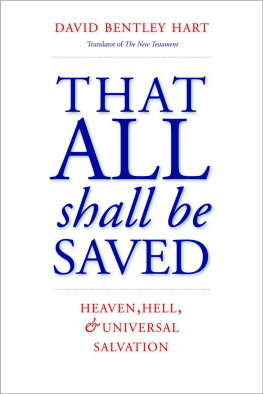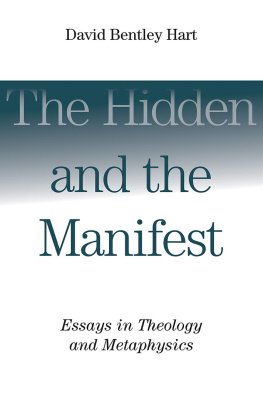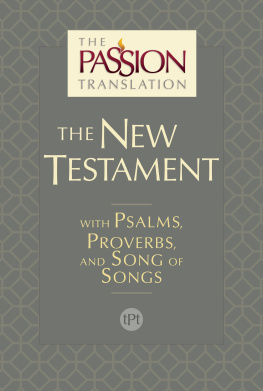THE NEW TESTAMENT

THE NEW TESTAMENT

A TRANSLATION
David Bentley Hart

Published with assistance from the Mary Cady Tew Memorial Fund.
Copyright 2017 by David Bentley Hart.
All rights reserved.
This book may not be reproduced, in whole or in part, including illustrations, in any form (beyond that copying permitted by Sections 107 and 108 of the U.S. Copyright Law and except by reviewers for the public press), without written permission from the publishers.
Yale University Press books may be purchased in quantity for educational, business, or promotional use. For information, please e-mail (U.K. office).
Designed by Sonia Shannon.
Set in Janson type by Tseng Information Systems, Inc.
Printed in the United States of America.
Library of Congress Control Number: 2017939708
ISBN 978-0-300-18609-3 (hardcover : alk. paper)
A catalogue record for this book is available from the British Library.
This paper meets the requirements of ANSI / NISO Z 39.48-1992 (Permanence of Paper).
10 9 8 7 6 5 4 3 2 1
For John Milbank
:
.
Contents
Acknowledgments
MY THANKS PRINCIPALLY to Jennifer Banks of Yale University Press for suggesting this project, after Iin keeping with a discreditable appetite for the needlessly recherchhad proposed producing a translation of either some of Ronsards verse or the whole of Quintus of Smyrnas Posthomerica. I had not realized how deeply this labor would affect me, and she can have no way of knowing what I owe her for having given it to me. (Gha bhra.) I am also grateful to her and the other editors at Yale for their patience: the translation was interrupted for over a year and a half by a particularly debilitating illness I contracted, and not once did any representative of Yale University Press give me cause to feel I was letting down the side. I am especially indebted to Lawrence Kenney, the copy editor of this book, for his keen diligence and his patience, and for rescuing me from my own omissions.
My thanks to my brother Addison for our conversations regarding various words in the original Greek, for encouraging me in my resolve to resist the easy path of adopting conventional solutions to difficult interpretive problems, and for agreeing with me on certain translations that otherwise I might have decided were too outlandish (even though correct). My thanks as well to my mother, Marianne Hart, for typing out long portions of this translation when I was too ill to do it for myself. And thanks too to Jacob Prahlow, my research assistant at Saint Louis University, for proofreading the texts of the four Gospels with such care and for removing the typographical errors from those manuscripts for me.
I am especially grateful to Robert L. Wilken, both for the encouragement he offered me with regard to the finished product and for his suggestions on how to reorganize the introductory and critical materials. And I am very grateful indeed to the editors of Commonweal for permission to adapt portions of an article that I originally published in the pages of their journal (Christs Rabble, 7 October 2016) for my introduction to this volume.
A Note on Transliteration
IN MY INTRODUCTION and footnotes I have many occasions to transliterate Greek words into Latin lettering, and for the most partinasmuch as the phonetic correspondences are mostly obviousI do so quite conventionally. But I should note that the pronunciation I assume to be correct is that of modern demotic. While it is possible to debate the degree to which modern Greek pronunciation matches that of late antiquity, there can be no serious doubt that it comes much nearer to doing so than does the accent invented by sixteenth-century Western European humanists, which corresponds to no version of spoken GreekHomeric, Attic, koin, Mediaeval, Katharevousa, Demoticever heard on the lips of a native speaker. It is not difficult to find plays on words in late antique texts that are entirely invisible unless one is reading the words as having demotic vowel values; and we have enough specimens of phonetically induced misspellings (scrawled on certain ancient Cappadocian monastic walls, for instance) or homophonous variant spellings of transliterations (for instance, Matthew 27:46 and Mark 15:34) to confirm that late antique speakers of Greek used an accent at least very close to that of modern Greek. It is something of a mystery that classicists are still taught to lisp Sophocles or Plato in the entirely artificial and really rather hideous intonations of what is often called Erasmian Greek. This affects my text in only a limited way, but one that needs some clarification. I have not attempted to demoticize every aspect of my transliteration, for fear of producing something unintelligible. I have eschewed the classicist habit of rendering a rho as rh rather than r, but I have also resisted the demotic temptation to render every delta as dh rather than d, however much I might wish to try to capture the lovely, melting, soft th sound that the consonant has in spoken Greek. Neither have I rendered beta as v, which would baffle far too many readers, as would also happen if I tried to render the softness of the modern Greek gamma, or wrote it as a consonantal y before an epsilon or iota. And sadly there is no intelligible way to represent the diphthong omicron-iota in such a way as to make readers hear it as an English long e rather than the obnoxious and philologically indefensible oy of Western European sixteenth-century convention. I have used a long mark over the o that represents omega, to distinguish it from omicron, even though the latter is short more durationally than tonally in modern Greek; to Anglophone ears, it would still sound long. (The long pronunciation of both e and o is the same as in English.) I have also made the h that represents the hard breathing mark over certain vowels a superscript, to make clear that ideally it should be voiced somewhere along the continuum from extremely softly to silently. I have similarly made the iota-subscript of singular datives into a subscript in English also. And I have rendered the letter ypsilon (not, as it is often mispronounced, upsilon) by three separate letters: y, u, and v. Where the ypsilon is simply an isolated vowel it becomes a y, just as we are accustomed to seeing it rendered in such words as physics or psychology, and it should always be pronounced like an English long e. And, just as u and v were really one letter in classical Latin, functioning at times as the vowel and at times as the consonant, something similar is true of the ypsilon: It can serve as a vowel, sounded either with its own y sound or, after an omicron, as producing the diphthong ou, which sounds like the double-o in boot; but it can serve also as a consonant, after an alpha, eta, or epsilon, where it produces either a v or an f sound, depending on what letter follows it, and in those cases I have rendered it as a v (think of it as sometimes an English v, sometimes a German).
Introduction
The Purpose of This Translation
Next page














